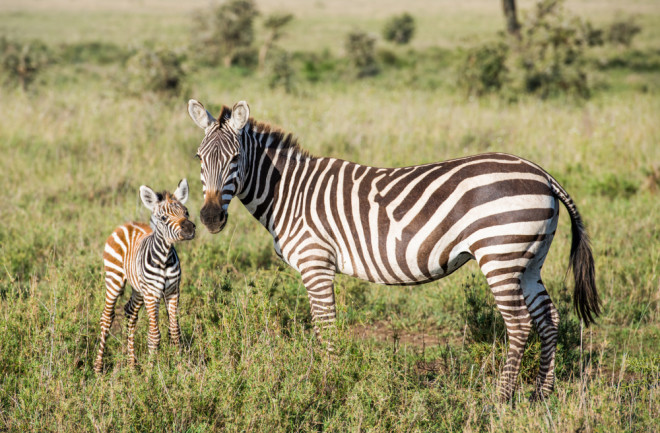When Ben Alessio visited the Birch Aquarium in San Diego, he found an unexpected clue to an age-old biological question: How do animals get their spots and stripes?
On one level the answer is simple; it’s easy to see how they could’ve evolved as camouflage or warning signals, or as a way to attract mates. But evolutionary explanations don’t get at the deeper problem: How, in a nitty-gritty mechanistic sense, do these patterns develop in individual animals?
Because on the face of it, they don’t make much sense. When colors interact, we typically expect them to diffuse until they reach a bland equilibrium. Pour milk into your coffee and you don’t get interesting patches of brown and white like a leopard’s coat — you get 8 ounces of uniform beige.
What Are Turing Patterns?
Yet Alan Turing, better known as a mathematician, computer science pioneer, and father of what would come to be called the Turing Test, showed how it could work in his seminal 1952 paper, “The Chemical Basis of Morphogenesis.”
Read More: Alan Turing’s Only Chemistry Paper
As tissues develop, he thought, various pigment chemicals diffuse throughout them like milk in coffee. The difference here is that the chemicals react with and inhibit each other in such a way that they counteract diffusion: Some form spots, others form empty spaces between spots, and all the different regions coexist in what we today call “Turing patterns.”
Alessio, now a Ph.D. student in mechanical engineering at Stanford, explained the seemingly paradoxical nature of these patterns. “The basic idea,” he says, “is you have something homogeneous, and a heterogeneous system is coming out of it.”
Turing’s innovative mathematics made a good starting point, but they don’t quite map onto reality. In his models the boundaries between colors are fuzzy, each shade blurring into the next. But then, why do zebras have stripes, for example? More specifically, why do their stripes have crisp lines separating black from white — no gray area? So, the theory is incomplete, as researchers have known for decades.
Read More: Why Do Zebras Have Stripes? Maybe to Help Keep Cool
What Alessio discovered at the aquarium could be the next piece of the puzzle, however. Before the trip, he’d been running computer simulations that produced Turing patterns, only sharper. And then, he recalled, “it all came together when I saw this fish that looked exactly like the simulations.”
It was a boxfish, covered in a spectacular grid of fine yellow hexagons, each with a brilliant blue dot at the center surrounded by black space. Eager to find out if this might be a real-world example of what he’d seen on the screen, he mentioned it to Ankur Gupta, a chemical engineer at the University of Colorado Boulder, where Alessio was then a research assistant. The two got straight to work.
“For the next few days, we kind of went crazy trying to replicate the pattern,” Gupta says, and in the end they did.
What Is Diffusiophoresis?
Their insight, described in a recent Science Advances paper, was to combine Turing’s theory with a process called diffusiophoresis — it’s the same simple mechanism that leaves your laundry fresh and clean after a good sudsing. When soap particles flow away from the clothes (where they’re highly concentrated) and into clean water (where they’re less concentrated), they drag dirt particles out with them.
More broadly, in any solution with a concentration gradient, the force of diffusion propels whatever larger particles happen to be hanging around. In this case those large particles are chromatophores, which give color to many animals, including fish, reptiles and amphibians (mammals and birds have a different kind of pigment cell, called melanocytes). Diffusiophoresis draws them together into discrete banded structures — spots and stripes.
Read More: 4 Hidden Ways Animals Camouflage Themselves
When Alessio and Gupta ran new simulations of Turing patterns augmented by diffusiophoresis, they were able to create much more defined outlines. Neither process by itself could reproduce the ornate boxfish designs, but the combination of the two was an almost perfect match.
Mysteries of Morphogenesis
When Turing published his theory, he had in mind something much grander than just skin patterns. He wanted to explain the diverse mysteries of morphogenesis, the process by which organisms are shaped — how their cells, tissues and organs differentiate and grow into such complex finished products.
Alessio and Gupta likewise believe their contribution could help answer a wide range of biological questions, about everything from tumor formation to embryo development. They also hope these ideas will prove useful in new technologies, like artificial camouflage, or skin patches capable of diagnosing medical conditions.
Gupta notes, however, that this blend of Turing’s mathematics with diffusiophoresis is not necessarily a complete explanation. They’re not discounting other processes that might be at play in morphogenesis (such as chemotaxis, the migration of cells in response to chemical stimuli, which has been proposed as another way cells could arrange themselves). Rather, they’re highlighting the potential significance of one process they feel has been under-appreciated.
And they acknowledge their model is theoretical. To fully understand how patterns arise in living organisms, researchers will have to move beyond simulations and investigate those organisms directly — a biological context that may be far more complicated. “Certainly,” Gupta says, “in a real system there could be other factors.”
Read More: 6 Unusual Traits of Animal Evolution

